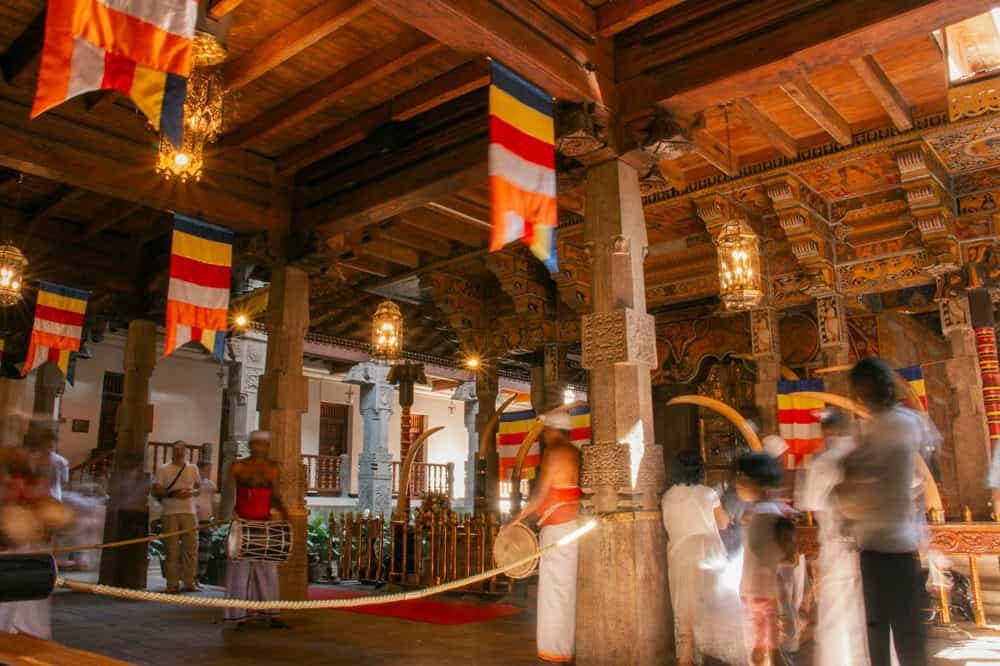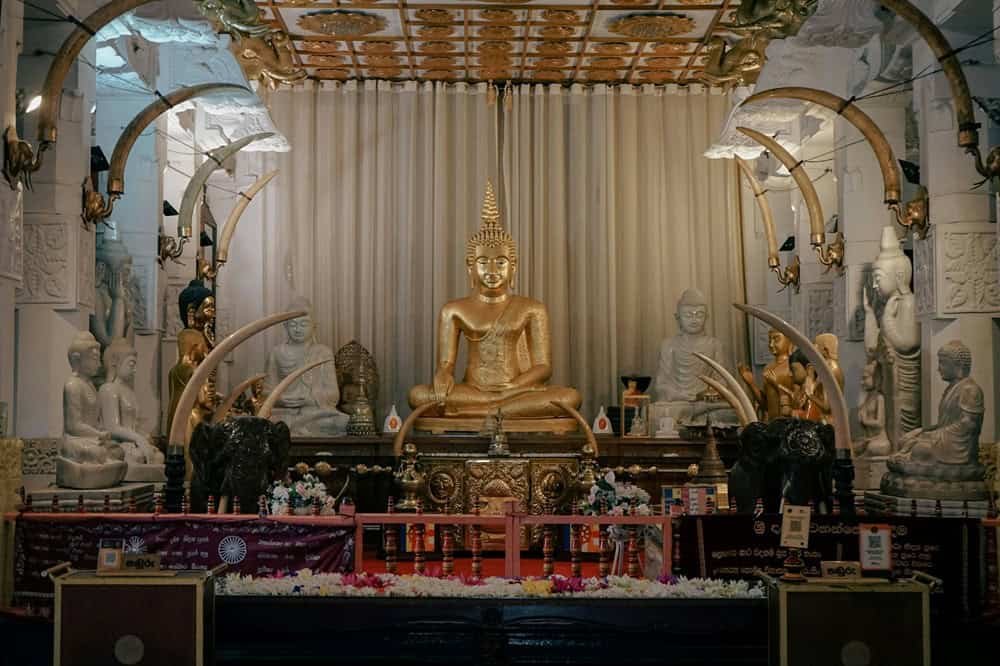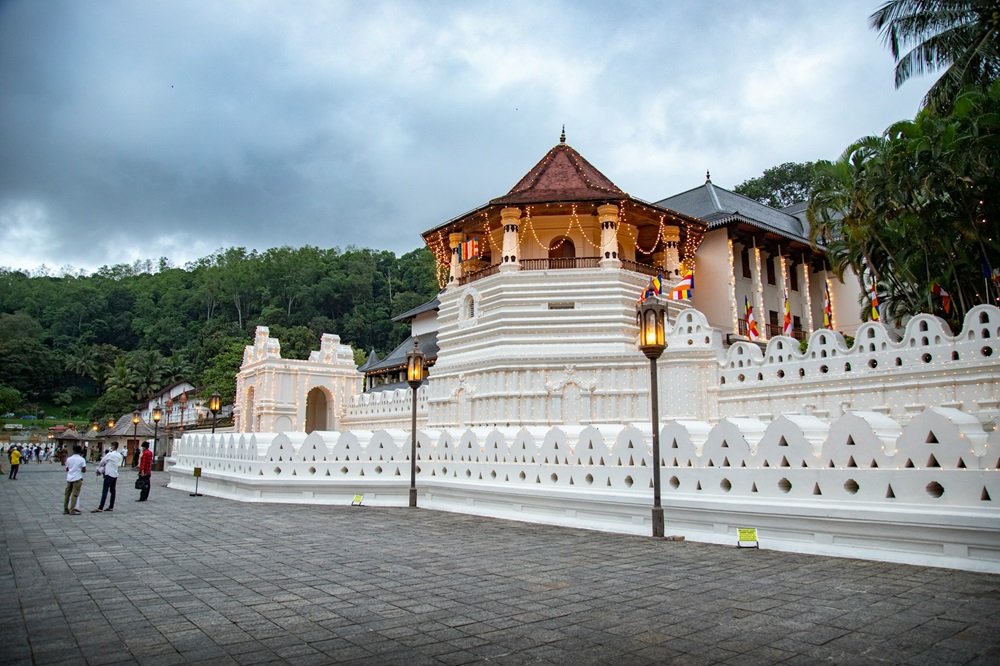Temple of Tooth
- Sri Lanka
Overview
If you’ve ever found yourself daydreaming about Sri Lanka’s history and culture. The Temple of the Tooth might have crossed your mind.
Located in the beautiful city of Kandy, this iconic temple isn’t just a place to worship; whereas it’s a proof of history, which is full of stories that go back centuries.
Therefore, whether you’re planning a visit or simply curious about what makes this place so special. You’re about to learn something interesting.
In fact, this article will cover everything you need to know about the Temple of the Tooth. From its fascinating past to practical tips for visiting.
Moreover, we’ll share some fun facts and travel advice to make your experience as smooth and memorable as possible.
So grab your favourite drink (or coffee; no judgment here), and let’s dive into the details of this sacred place.



What is the Temple of Tooth?
To be honest, calling the Temple of the Tooth for a “temple” feels like something unique, right?
Well, officially known as Sri Dalada Maligawa. This UNESCO World Heritage Site is home to one of Buddhism’s most revered relics.
That is because it is believed that Lord Buddha’s tooth has been stored in this temple.
For that reason, it holds immense spiritual significance not only for Sri Lankans but also for Buddhists around the globe.
Plus, the temple itself is a stunning example of traditional Kandyan architecture. That combines wood carvings, golden decorations, and fascinating courtyards.
Moreover, its location within the royal palace complex adds another layer of historical depth. By making it a must-visit for anyone who is exploring Sri Lanka.
To put it simply, the Temple of the Tooth is more than just a religious site. As a matter of fact, it’s a symbol of faith, artistry, and cultural heritage all in one.
History of the Temple of the Sacred Tooth Relic
The story of the Temple of Tooth is as fascinating as the relic it houses.
Legend has it that the tooth was smuggled out of India after the Buddha’s passing. By keeping it hidden in the hair of a princess named Hemamali.
Then, she and her husband, Prince Dantha. Brought the sacred relic to Sri Lanka, where it became a symbol of legitimacy for rulers.
With that, over the centuries, the tooth travelled across the island by finding a place to protect it in various kingdoms. Before finally settling in Kandy in the 16th century.
Interestingly, the temple wasn’t built overnight; whereas it evolved over time, with each ruler adding their own touch to its appearance.
Furthermore, during the periods of foreign invasions. The tooth was often in a safe spot to protect it from being seized by showing its immense value.
Conversely, its survival through wars and colonial rule. Speaks the real value of the resilience of the people who safeguarded it.
Therefore, as of today, the temple stands as a respected place in Sri Lanka’s rich spirit. And a profound connection to Buddhism.
Religious & Cultural Significance
When it comes to understanding the importance of the Temple of the Tooth, you will surely be impressed by its fascinating symbolism in Sri Lanka.
Anyway, for Buddhists, the tooth relic is considered as the most crucial embodiment of the Buddha’s presence on Earth.
Whereas Sri Lankans and other Buddhists around the world believe that whoever possesses the relic. Holds both spiritual and power, which explains why it has historically aligns with the country’s history.
Moreover, the temple serves as a place for religious ceremonies. By inviting pilgrims from far and wide who come to pay their respects.
Beyond its spiritual role, the Temple of Tooth plays a vital part in Sri Lanka’s cultural identity as well.
Plus, traditional sounds, dance, and rituals are deeply closeby to the temple’s activities. By creating a vibrant vibe of customs that have been passed down through generations.
To be honest, even if you’re not particularly religious. It’s impossible not to feel moved by the depth that holds in this temple.
For that reason, the temple isn’t just a sacred area. In other words, we can say that it’s a living museum of Sri Lanka’s collective soul.
Temple of Tooth Opening Hours & Best Time to Visit
Now, let’s talk about some practical stuff because timing your visit in a proper way can make a huge difference.
So, in short, the Temple of the Tooth is open daily. Typically from 5:30 AM to 8:00 PM, though these hours can change slightly depending on special events or ceremonies.
Anyway, if you’re wondering when is the best time to visit is. Early mornings and late afternoons tend to be ideal.
That is because during this time, you can avoid the midday headcounts. And also get to experience the temple’s appearance in golden sunlight—a sight that’s truly magical.
Moreover, the puja (prayer) ceremonies are held three times a day—in the morning, midday, and evening. So it is worth planning your visit around those times as well.
Speaking of which, these rituals offer a touch into the daily spiritual practices at the temple. And provide a sense of calmness that’s hard to get elsewhere.
Conversely, if you’re keen on avoiding large groups of tourists, weekdays are generally less crowded compared to weekends.
Note: To be honest, it doesn’t matter when you go, the Temple of Tooth has a way of making you feel like you are in another world, so don’t stress too much about perfection—just enjoy the moment.
Temple of Tooth Tickets & Entry Fees (Foreigners & Locals)
Let’s get down to money.
So, how much does it cost to visit this incredible temple?
Well, for locals, entry is actually free, whether they’re attending a religious ceremony or during a regular time.
Foreigners, however, fall down to the category of purchasing tickets, which typically range from Rs. 1500 to Rs. 2000.
Speaking of which, these prices may go as Rs. 1500 for South Asian Association for Regional Cooperation Countries and Rs. 2000 for tourists from Thailand and Myanmar.
We know that this might seem quite expensive compared to other attractions in Sri Lanka. But trust us, it’s worth every penny.
Moreover, the ticket includes access to the temple’s museum. Which holds a fascinating collection of artefacts related to the tooth relic and its history.
Conversely, if you’re travelling on a tight budget. Consider visiting during one of the temple’s public ceremonies, where entry is often low.
Additionally, keep in mind that photography inside the main shrine is usually not something that you can do, so you might want to factor in extra fees if you’re hoping to capture professional-grade shots.
To be honest, the experience of standing in the presence of such a revered relic is priceless by making the entry fee feel like a small price to pay for a memory you’ll cherish forever.
Dress Code and Visitor Guidelines
Before you set foot in the Temple of Tooth, it’s crucial to familiarise yourself with its dress code and visitor guidelines.
For starters, being respectful is key.
Whereas both men and women should wear clothes that cover their shoulders and knees.
Tip: Consider long skirts, trousers, or sarongs paired with loose-fitting tops.
Moreover, visitors should remove their shoes before entering the temple premises, so bring a pair of socks if you’re worried about walking barefoot on hot surfaces or the sandy ground.
Conversely, if you forget to pack appropriate clothing, don’t stress about it; the temple offers shawls and wraps for rent at a minimal cost.
With that being said, beyond the dress code, there are a few other rules to keep in mind as well.
For instance, speaking loudly or behaving disrespectfully is not suitable, as the temple is a place of worship.
Furthermore, touching the relic or any object strictly falls into the red zone.
To be honest, following these guidelines isn’t just about showing respect—it’s also about ensuring that everyone, including yourself, has a peaceful and meaningful experience.
Note: Keep in mind that you cannot even wear a hat when entering the temple, as it may show disrespect for the religion and the culture.
Kandy Esala Perahera Festival & Temple Connection
If you’re lucky enough to visit Kandy in July, you cannot miss the Esala Perahera festival.
That is because this grand celebration is one of Sri Lanka’s most iconic events, and its meaning deeply highlights the value of the Temple of Tooth.
For that reason, the festival revolves around honouring the sacred tooth relic by featuring traditional costumes, drumming, fire dancers, and beautifully adorned elephants parading through the streets.
Moreover, the highlight of the festival is the Maligawa Perahera, a procession led by the temple’s chief custodian carrying a replica of the tooth relic.
Trust us, it’s a wonderful moment to capture, where you can see the combination of religion, culture, and artistry in a way that’s quite mesmerising.
With that, if you’re planning to attend, be prepared to deal with the crowd and book hotel reservations well in advance, as this event draws visitors from all over the world.
To be honest, experiencing the Esala Perahera for the first time is like living in a painting as it’s unique, full of energy, and fascinatingly beautiful all at once.
Note: Sri Lanka is the only place where you can witness a “Perahera” by sitting in the front row to feel the real vibe of the culture and the skills of Sri Lankans.
Things to See Inside the Temple of the Tooth
Once you step inside the Temple of Tooth, you’ll quickly realise that it’s not just a single shrine—it’s a complex that you can walk around.
Anyway, the centrepiece, of course, is the inner sanctum where the tooth relic is housed.
Encased in a series of intricately designed golden caskets, the relic itself is rarely visible, but the aura of reverence surrounding it is fascinating.
Moreover, the temple’s architecture is a wonderful thing to see, with detailed carvings, frescoes, and gilded decorations in every corner.
Moreover, don’t miss the Audience Hall, which is supported by massive wooden pillars, or the courtyard where people light oil lamps as offerings.
Additionally, the temple’s museum offers a fascinating look at its history by showing you the ancient handwritten work of art and other artefacts.
Whereas every spot and corridor seems to tell a story by making it easy to lose track of time as you walk through this sacred temple.
In short, the Temple of Tooth is so much more than just a tourist attraction, as it’s proof that Sri Lanka holds an ancient history.
Whereas from its inspiring architecture to its respected religious aspects, every spot of this sacred site invites you to think about how people can build things.
Moreover, whether you’re walking through the golden caskets that house the tooth relic, experiencing the energy of the Esala Perahera festival, or simply happy to go through its courtyards, there’s something magical about the experience.
In other words, visiting the Temple of Tooth isn’t just about checking off a box on your travel itinerary—it’s about connecting with something timeless and universal.
For that reason, no matter where you come from or what you believe, this is a place that will leave an incredible mark on your heart.
Get a Quote!
Your Expert Partners in
Travel Planning
Planning a vacation should feel exciting—not overwhelming. That’s where we come in. With a deep understanding of destinations, logistics, and what makes a trip truly special, our team of travel professionals handles every detail for you.

